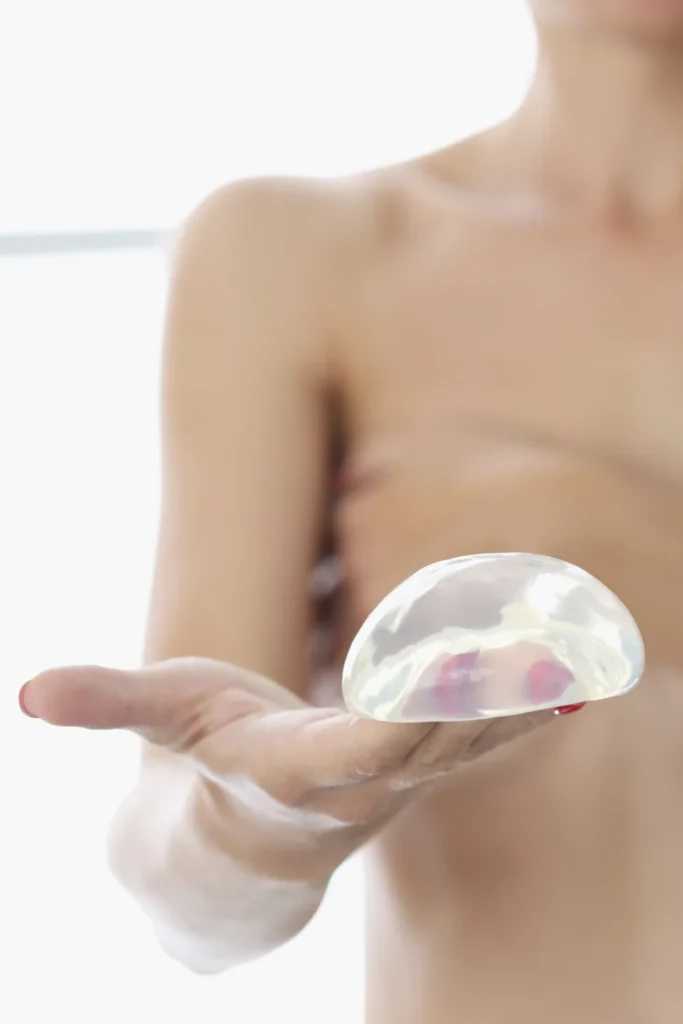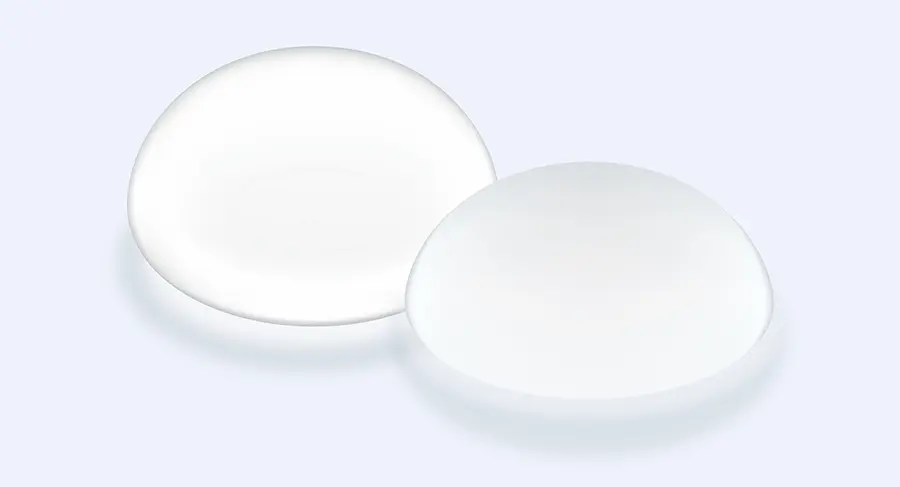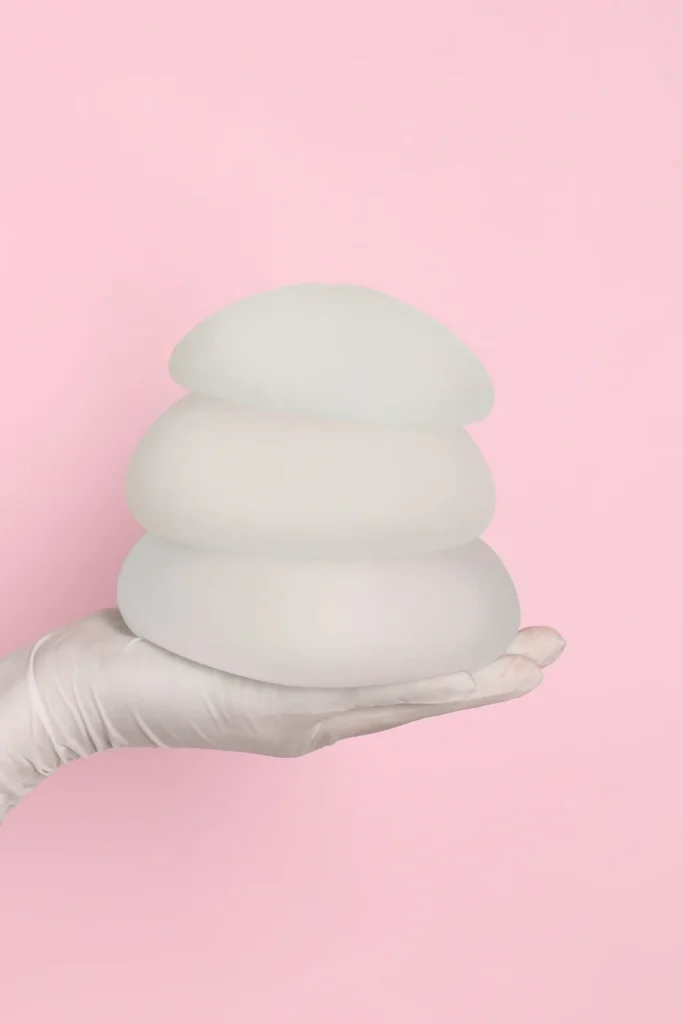Choosing the right breast implants can be an important decision. But with so many options available, how do you know which type is right for you?
The debate between saline vs silicone implants has been ongoing for years, and for good reason. Both have their merits and drawbacks, and understanding these can make all the difference in your breast augmentation journey. Let’s explore their compositions, pros, cons, and everything in between.
Looking to schedule a consultation for scarless breast implants today? Contact us now to get started on your journey with your award-winning plastic surgeon, Dr. Adrian Lo!
Saline Implants Explained

Saline implants have been a popular choice for breast augmentation since their FDA approval in 2000. These implants consist of a silicone shell filled with sterile salt water, offering a customizable solution for many women.
Despite the rise of silicone alternatives, saline implants continue to be favored by some plastic surgeons and patients for their unique benefits.
Composition and Structure
Saline implants are essentially empty silicone shells that are filled with sterile salt water after being inserted into the breast pocket. This allows for smaller incisions during surgery, as the implant can be rolled up and inserted before being filled.
The filling process allows for some degree of customization, as the plastic surgeon can adjust the volume of saline to achieve the desired size and symmetry during surgery. This flexibility is particularly beneficial for patients with naturally asymmetrical breasts. The saline solution used is similar to what’s found in IV fluids, making it completely safe for the body in case of a rupture.
Pros of Saline Implants
- Small incision required for insertion: This can lead to less noticeable scarring and potentially quicker recovery times. In the event of a rupture, saline implants are considered safe as the body can naturally absorb the salt water solution without any health risks. This safety aspect provides peace of mind for many patients. If the saline implant leaks or deflates, the patient will know right away, as the breast becomes smaller.
- Can achieve a larger size, rounder perkier look.
- Generally less expensive than their silicone counterparts, making them a more budget-friendly option for some patients.
Cons of Saline Implants
- Many patients report that they feel less natural than silicone implants, especially in women with little natural breast tissue.
- The implants can sometimes be visible under the skin, creating a “rippling” effect that some find unappealing. This is particularly noticeable in thinner women or those with less breast tissue to cover the implant. Sometimes one may also feel wrinkling and rippling of the saline implant underneath the breast tissue.
- Saline implants also tend to feel firmer and less like natural breast tissue compared to silicone options. Some patients describe them as feeling more like water balloons than natural breasts.
- Ruptures are safe, but they’re immediately noticeable as the breast will deflate, potentially leading to asymmetry until the implant can be replaced. However, this can be a benefit as well, as silicone implant ruptures may not be detected right away.
Silicone Implants Explained

Silicone implants have a long and somewhat controversial history in the world of breast augmentation. First introduced in the 1960s, they were temporarily taken off the market in 1992 due to safety concerns. However, after extensive studies, the FDA reapproved silicone implants for cosmetic use in 2006. Today, silicone implants are often considered the gold standard in breast augmentation, praised for their natural look and feel.
Composition and Structure
Silicone implants consist of a silicone outer shell filled with silicone gel. This gel can vary in consistency, from a more liquid-like substance to a firmer, cohesive gel often referred to as “gummy bear” implants. The cohesive gel is designed to hold its shape even if the implant shell is broken, reducing the risk of silicone migration in case of rupture.
The structure of silicone implants allows them to closely mimic the feel of natural breast tissue. They come pre-filled in a variety of sizes, projections and shapes, including round and teardrop options. The outer shell is usually smooth as textured shells are no longer available.
Pros of Silicone Implants
- Natural look and feel. Many patients and plastic surgeons agree that silicone implants more closely resemble natural breast tissue, making them an excellent choice for women with little natural breast tissue. They tend to move more naturally with the body and are less likely to show or have palpable rippling or wrinkling under the skin.
- They come in a wider variety of shapes and sizes, allowing for more customization to fit individual body types and desired outcomes. They’re particularly beneficial for women with little or no natural breast tissue as it provides a more natural feel.
- Some studies suggest that silicone implants may have a lower rate of capsular contracture, a common complication where scar tissue forms around the implant.
Cons of Silicone Implants
- Silent ruptures. Unlike saline implants, a rupture in a silicone implant may not be immediately noticeable as the gel tends to stay within the implant shell or surrounding capsule. The breast size usually stays the same. This necessitates regular mammogram screenings to check for ruptures and sometimes a breast ultrasound or MRI may be necessary. This can lead to additional expenses but should be covered under most health insurance plans.
- Require a slightly larger incision for insertion, as they come pre-filled. This can result in slightly more noticeable scarring compared to saline implants.
- Typically more expensive than saline implants, which can be a deciding factor for some patients. In rare cases of rupture and silicone migration, removal can be more complicated than with saline implants.
Comparing Saline and Silicone Implants

Understanding the key differences between silicone vs. saline implants is crucial for making an informed decision, as each type has distinct characteristics that may impact your satisfaction with the results. Let’s explore the differences between these two popular implant types.
Feel and Appearance
Silicone implants are praised for their natural feel, as they closely mimic the softness and movement of natural breast tissue, which is an important consideration for many patients. This is particularly beneficial for women with little natural breast tissue, as the implant is less likely to be noticeable under the skin.
Saline implants, on the other hand, tend to feel firmer and less natural, especially in women with minimal breast tissue. They’re more prone to visible rippling or wrinkling, particularly along the sides and bottom of the breast. However, in women with more natural breast tissue to cover the implant, this difference may be less noticeable and saline implants may be a good option.
In terms of appearance, both types can provide excellent results when placed by a skilled plastic surgeon. Silicone implants tend to create a more natural-looking slope and contour to the breast, while saline implants may create a rounder, more fuller look. The choice between silicone vs saline breast implants often comes down to personal preference and body type.
Safety Considerations
When it comes to safety, both saline and silicone implants have been extensively studied and are considered safe by the FDA.
Saline implants have an advantage in the event of rupture. When considering rupture risks, it’s important to note that if a saline implant breaks, the sterile saltwater solution is harmlessly absorbed by the body, posing minimal health concerns. The rupture is immediately noticeable as the breast will deflate, allowing for prompt replacement if desired.
Silicone implants, while also considered safe, present a different scenario in case of rupture. Modern silicone implants use a cohesive gel that tends to stay within the implant shell or surrounding breast capsule if a rupture occurs. This is called a “silent rupture” as it is difficult to recognize on a physical exam. A silicone implant rupture can only be confirmed with a regular mammogram, ultrasound or MRI screening. There is no evidence that silicone gel poses significant health risks if it leaks and is contained in the breast capsule. However, some patients prefer saline breast implants as ruptures are immediately known and any saline leaks are harmlessly absorbed by the body.
It’s worth noting that both types of implants carry similar risks of other complications, such as capsular contracture or infection. Women with silicone implants should get regular breast screenings three years after their surgery and every two years after that to check for silent ruptures.
Cost Differences
When considering implants saline vs silicone, cost can be a factor.
Generally, saline implants are less expensive than silicone implants. The price difference can range from several hundred to a thousand dollars or more, depending on the specific type of implant and the plastic surgeon’s fees.
When evaluating implant longevity, it’s worth noting that while saline implants may have a lower initial cost, they typically have a slightly shorter lifespan compared to silicone implants. Silicone implants, particularly the newer “gummy bear” varieties, tend to have a longer lifespan. Additionally, the cost of regular breast screenings for silicone implants if not covered under health insurance should be factored into the long-term expense.
Note: the cost of the implants themselves is only a portion of the total cost of breast augmentation surgery. Other factors, such as plastic surgeon’s fees, facility costs, and anesthesia, often make up a larger portion of the overall expense. When making your decision, consider the total cost of the procedure and any potential future expenses, rather than focusing solely on the price difference between implant types.
Factors to Consider When Making the Choice Between Silicone and Saline Implants
Choosing between saline vs. silicone implants options is a highly personal decision that should be made after careful consideration and consultation with a board-certified plastic surgeon.
Body Type and Existing Breast Tissue
Women with less natural breast tissue may benefit more from silicone implants, as they tend to look and feel more natural under thinner breast tissue. Saline implants, on the other hand, may be a good option for women with more natural breast tissue to cover the implant.
Silicone implants come in a variety of shapes, including profile options that can create a more natural-looking slope to the breast. This can be particularly beneficial for women with a longer torso or those desiring a more subtle enhancement. Saline implants typically create a rounder, more pronounced look, which some women prefer.
It’s also worth considering how your choice may be affected by future changes in your body. For instance, if you plan to lose or gain a significant amount of weight, or if you’re planning future pregnancies, discuss with your plastic surgeon how these factors might influence your choice between saline and silicone implants.
Desired Outcome
Your aesthetic goals play a significant role in choosing between saline implants vs silicone. If achieving the most natural look and feel possible is your primary goal, silicone implants may be the better choice. They tend to move more naturally with the body and are less likely to show rippling or wrinkling under the skin.
However, if you’re aiming for a more pronounced, rounded look, saline implants might better suit your goals. They can create a firmer, more defined shape that some women prefer.
In addition, sizes of silicone implants are fixed whereas saline implants can be filled within a range of the implant size offering the ability for customization during surgery allowing for more precise correction of breast asymmetry.
Customize Your Breast Implants with Board Certified Plastic Surgeon Dr. Adrian Lo!
Choosing between saline vs silicone implants is a significant decision that requires careful consideration of various factors, including feel, appearance, safety, and cost.
There’s no one-size-fits-all solution when it comes to breast augmentation. The key is to work closely with a board-certified plastic surgeon who can guide you through the decision-making process and help you achieve the best possible results.
Dr. Adrian Lo, a renowned expert in breast implant surgery offers personalized consultations to help you make an informed decision. Schedule a consultation with Dr. Lo today and take the first step towards achieving your ideal breast enhancement results!
